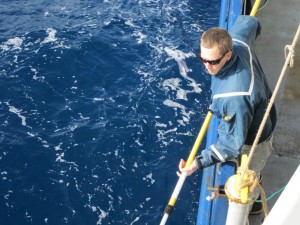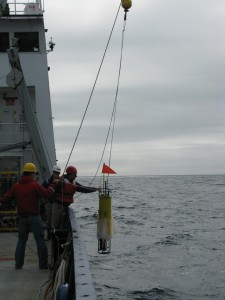5 November 2012
Jot some field notes, get printed in The New York Times
Posted by mcadams

AGU member Jim Thomson wrote about his month-long research at sea for the New York Times' "Scientists at Work" blog. Thompson is the Principal Oceanographer for the University of Washington’s Applied Physics Laboratory in Seattle. Photo by Stephanie Downey.
Oceanographer Jim Thomson was surprised when The New York Times accepted his pitch to blog for the newspaper from a research cruise. Next thing he knew, his writing showed up as a full-blown article in the October 16 Science Times (circulation about 1 million).
I have just returned from a month at sea conducting research on wave breaking. During the project, I wrote entries in the New York Times “Scientist at Work” blog (http://scientistatwork.blogs.nytimes.com/author/jim-thomson/). It was great outreach opportunity, although it admittedly happened on a whim.
Before leaving, I wrote a sample post and sent it in to the NYT editor by email, at the suggestion of the media relations person at my university. I did not expect they would take the pitch…. and when they did, my first thought was “uh-oh, now I have to write more.” Field work is exhausting enough, now I was going to add writing deadlines.
I gave myself some structure. I set an early alarm and wrote in the mornings, sneaking down to the galley for a first cup of coffee and then retreating to my cabin for an hour. I decided I would attempt only one scientific idea per post. The rest would be the story of our trip out to the middle of the North Pacific Ocean.
Focusing on the story came more and more easily as we went, and I began to think of a second goal to these posts: to show that we scientists are human too. I wanted to show the anxiety and the excitement of preparations, the satisfaction and pride of getting data back, and sobering realization of how complicated the data analysis will be in the coming months and years.
In the end, with seven NYT posts and one idea at a time, I described enough wave physics to get to breaking (my speciality). I tried to place these descriptions in historical context, so that readers would see the continuum of scientific progress (and the many gaps left to be filled). Just as we were returning from sea, the blog entries were selected for print publication in the Tuesday Science Times. (Prior to this, I did not know that was a possibility.) I am coming to think of science writing for a general audience much like technical writing for academic journals: produce as much as you can at the highest quality you can– you never know what someone might find useful.
— Jim Thomson, PhD, AGU member and Principal Oceanographer for the University of Washington’s Applied Physics Laboratory in Seattle



 The Plainspoken Scientist is the science communication blog of AGU’s Sharing Science program. With this blog, we wish to showcase creative and effective science communication via multiple mediums and modes.
The Plainspoken Scientist is the science communication blog of AGU’s Sharing Science program. With this blog, we wish to showcase creative and effective science communication via multiple mediums and modes.
That sounds adventurous and a serious work. My son dreams to be a scientist one day, will have him read your blog and see what he thinks about being an Oceanographer. I’m sure we will love the idea of being in the ocean for months 🙂